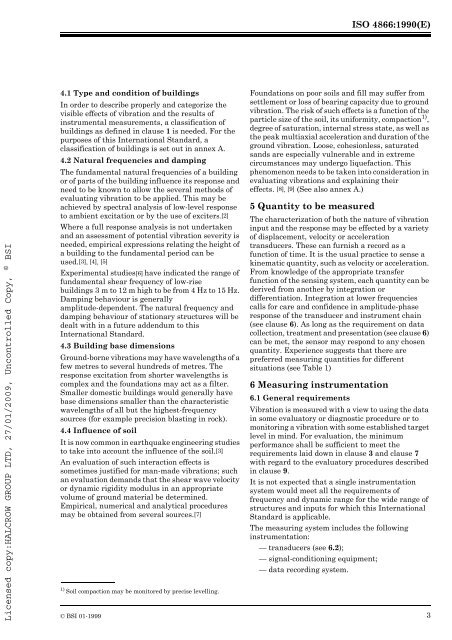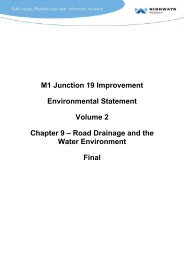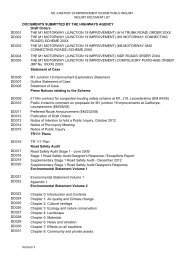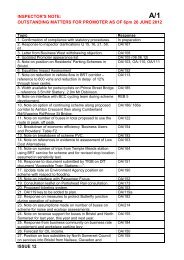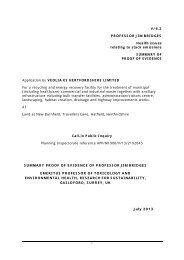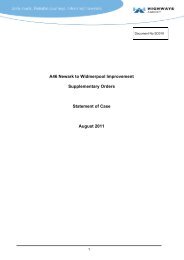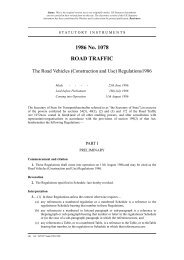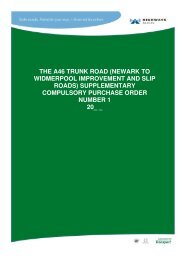Evaluation and Measurement for Vibration in Buildings Part 1, BSI ...
Evaluation and Measurement for Vibration in Buildings Part 1, BSI ...
Evaluation and Measurement for Vibration in Buildings Part 1, BSI ...
Create successful ePaper yourself
Turn your PDF publications into a flip-book with our unique Google optimized e-Paper software.
ISO 4866:1990(E)<br />
Licensed copy:HALCROW GROUP LTD, 27/01/2009, Uncontrolled Copy, © <strong>BSI</strong><br />
4.1 Type <strong>and</strong> condition of build<strong>in</strong>gs<br />
In order to describe properly <strong>and</strong> categorize the<br />
visible effects of vibration <strong>and</strong> the results of<br />
<strong>in</strong>strumental measurements, a classification of<br />
build<strong>in</strong>gs as def<strong>in</strong>ed <strong>in</strong> clause 1 is needed. For the<br />
purposes of this International St<strong>and</strong>ard, a<br />
classification of build<strong>in</strong>gs is set out <strong>in</strong> annex A.<br />
4.2 Natural frequencies <strong>and</strong> damp<strong>in</strong>g<br />
The fundamental natural frequencies of a build<strong>in</strong>g<br />
or of parts of the build<strong>in</strong>g <strong>in</strong>fluence its response <strong>and</strong><br />
need to be known to allow the several methods of<br />
evaluat<strong>in</strong>g vibration to be applied. This may be<br />
achieved by spectral analysis of low-level response<br />
to ambient excitation or by the use of exciters.[2]<br />
Where a full response analysis is not undertaken<br />
<strong>and</strong> an assessment of potential vibration severity is<br />
needed, empirical expressions relat<strong>in</strong>g the height of<br />
a build<strong>in</strong>g to the fundamental period can be<br />
used.[3], [4], [5]<br />
Experimental studies[6] have <strong>in</strong>dicated the range of<br />
fundamental shear frequency of low-rise<br />
build<strong>in</strong>gs 3m to 12 m high to be from 4 Hz to 15 Hz.<br />
Damp<strong>in</strong>g behaviour is generally<br />
amplitude-dependent. The natural frequency <strong>and</strong><br />
damp<strong>in</strong>g behaviour of stationary structures will be<br />
dealt with <strong>in</strong> a future addendum to this<br />
International St<strong>and</strong>ard.<br />
4.3 Build<strong>in</strong>g base dimensions<br />
Ground-borne vibrations may have wavelengths of a<br />
few metres to several hundreds of metres. The<br />
response excitation from shorter wavelengths is<br />
complex <strong>and</strong> the foundations may act as a filter.<br />
Smaller domestic build<strong>in</strong>gs would generally have<br />
base dimensions smaller than the characteristic<br />
wavelengths of all but the highest-frequency<br />
sources (<strong>for</strong> example precision blast<strong>in</strong>g <strong>in</strong> rock).<br />
4.4 Influence of soil<br />
It is now common <strong>in</strong> earthquake eng<strong>in</strong>eer<strong>in</strong>g studies<br />
to take <strong>in</strong>to account the <strong>in</strong>fluence of the soil.[3]<br />
An evaluation of such <strong>in</strong>teraction effects is<br />
sometimes justified <strong>for</strong> man-made vibrations; such<br />
an evaluation dem<strong>and</strong>s that the shear wave velocity<br />
or dynamic rigidity modulus <strong>in</strong> an appropriate<br />
volume of ground material be determ<strong>in</strong>ed.<br />
Empirical, numerical <strong>and</strong> analytical procedures<br />
may be obta<strong>in</strong>ed from several sources.[7]<br />
1)<br />
Soil compaction may be monitored by precise levell<strong>in</strong>g.<br />
Foundations on poor soils <strong>and</strong> fill may suffer from<br />
settlement or loss of bear<strong>in</strong>g capacity due to ground<br />
vibration. The risk of such effects is a function of the<br />
particle size of the soil, its uni<strong>for</strong>mity, compaction 1) ,<br />
degree of saturation, <strong>in</strong>ternal stress state, as well as<br />
the peak multiaxial acceleration <strong>and</strong> duration of the<br />
ground vibration. Loose, cohesionless, saturated<br />
s<strong>and</strong>s are especially vulnerable <strong>and</strong> <strong>in</strong> extreme<br />
circumstances may undergo liquefaction. This<br />
phenomenon needs to be taken <strong>in</strong>to consideration <strong>in</strong><br />
evaluat<strong>in</strong>g vibrations <strong>and</strong> expla<strong>in</strong><strong>in</strong>g their<br />
effects. [8], [9] (See also annex A.)<br />
5 Quantity to be measured<br />
The characterization of both the nature of vibration<br />
<strong>in</strong>put <strong>and</strong> the response may be effected by a variety<br />
of displacement, velocity or acceleration<br />
transducers. These can furnish a record as a<br />
function of time. It is the usual practice to sense a<br />
k<strong>in</strong>ematic quantity, such as velocity or acceleration.<br />
From knowledge of the appropriate transfer<br />
function of the sens<strong>in</strong>g system, each quantity can be<br />
derived from another by <strong>in</strong>tegration or<br />
differentiation. Integration at lower frequencies<br />
calls <strong>for</strong> care <strong>and</strong> confidence <strong>in</strong> amplitude-phase<br />
response of the transducer <strong>and</strong> <strong>in</strong>strument cha<strong>in</strong><br />
(see clause 6). As long as the requirement on data<br />
collection, treatment <strong>and</strong> presentation (see clause 6)<br />
can be met, the sensor may respond to any chosen<br />
quantity. Experience suggests that there are<br />
preferred measur<strong>in</strong>g quantities <strong>for</strong> different<br />
situations (see Table 1)<br />
6 Measur<strong>in</strong>g <strong>in</strong>strumentation<br />
6.1 General requirements<br />
<strong>Vibration</strong> is measured with a view to us<strong>in</strong>g the data<br />
<strong>in</strong> some evaluatory or diagnostic procedure or to<br />
monitor<strong>in</strong>g a vibration with some established target<br />
level <strong>in</strong> m<strong>in</strong>d. For evaluation, the m<strong>in</strong>imum<br />
per<strong>for</strong>mance shall be sufficient to meet the<br />
requirements laid down <strong>in</strong> clause 3 <strong>and</strong> clause 7<br />
with regard to the evaluatory procedures described<br />
<strong>in</strong> clause 9.<br />
It is not expected that a s<strong>in</strong>gle <strong>in</strong>strumentation<br />
system would meet all the requirements of<br />
frequency <strong>and</strong> dynamic range <strong>for</strong> the wide range of<br />
structures <strong>and</strong> <strong>in</strong>puts <strong>for</strong> which this International<br />
St<strong>and</strong>ard is applicable.<br />
The measur<strong>in</strong>g system <strong>in</strong>cludes the follow<strong>in</strong>g<br />
<strong>in</strong>strumentation:<br />
— transducers (see 6.2);<br />
— signal-condition<strong>in</strong>g equipment;<br />
— data record<strong>in</strong>g system.<br />
© <strong>BSI</strong> 01-1999 3


